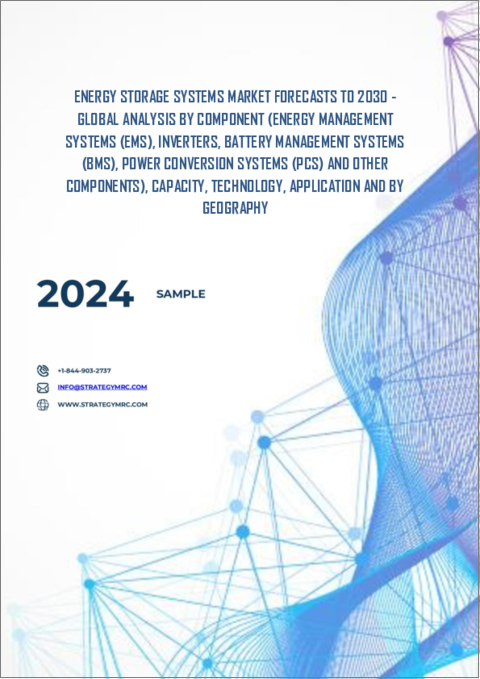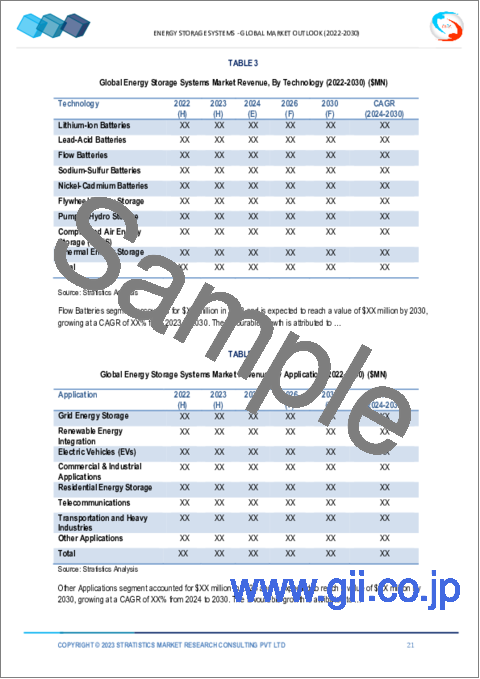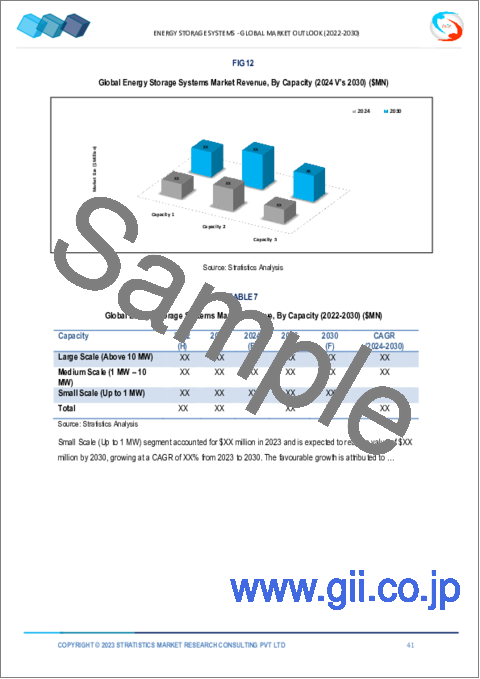|
|
市場調査レポート
商品コード
1569867
エネルギー貯蔵システム市場の2030年までの予測: コンポーネント別、容量別、技術別、用途別、地域別の世界分析Energy Storage Systems Market Forecasts to 2030 - Global Analysis By Component (Energy Management Systems, Inverters, Battery Management Systems, Power Conversion Systems and Other Components), Capacity, Technology, Application and By Geography |
||||||
カスタマイズ可能
|
|||||||
| エネルギー貯蔵システム市場の2030年までの予測: コンポーネント別、容量別、技術別、用途別、地域別の世界分析 |
|
出版日: 2024年10月10日
発行: Stratistics Market Research Consulting
ページ情報: 英文 200+ Pages
納期: 2~3営業日
|
全表示
- 概要
- 図表
- 目次
Stratistics MRCによると、世界のエネルギー貯蔵システム市場は2024年に2,640億5,000万米ドルを占め、予測期間中のCAGRは10.3%で成長し、2030年には4,755億米ドルに達すると予測されています。
エネルギー貯蔵システム(ESS)とは、エネルギーを回収、貯蔵、管理し、後で使用するために設計されたさまざまな技術や手法を指します。ESSは間欠性を調整し、エネルギーの安定供給を実現するため、風力発電や太陽光発電のような再生可能エネルギーの統合に不可欠です。この業界は、バッテリー、揚水発電、熱貯蔵など、商業用、産業用、住宅用のさまざまな技術を提供しています。
Institute for Energy Economics and Financial Analysis(IEEFA)によると、2018年、米国では太陽光発電と風力発電を中心とする再生可能エネルギー発電技術への投資が総額642億米ドルに達しました。
再生可能エネルギーの採用拡大
エネルギー貯蔵システム(ESS)は、太陽光発電や風力発電のような再生可能エネルギーの利用拡大により、高い需要があります。エネルギー貯蔵システム(ESS)は、これらの断続的なエネルギー源の出力が変動する可能性があるため、生産量のピーク時に余分なエネルギーを貯蔵し、生産量の少ない時期や需要の多い時期に放出するために極めて重要です。これはグリッド・バランシングに貢献し、一貫した持続可能なエネルギー供給を保証します。加えて、ESSは温室効果ガスの排出を最小限に抑え、化石燃料への依存度を下げるために利用できます。
高い初期投資コスト
エネルギー貯蔵システム(ESS)市場にとって、高い初期投資価格が大きなハードルとなっています。これには、電力変換、バッテリー管理、設備インフラだけでなく、バッテリーの設置価格も含まれます。システム制御、プラントバランス、建設、試運転は追加費用です。エネルギー貯蔵システムに関連する初期費用は、特に資金源が乏しい発展途上国では、その広範な導入を妨げる可能性があります。
バッテリー技術のコスト低下
バッテリー技術の低価格化が、エネルギー貯蔵システム(ESS)市場の成長を促しています。電池は、製造効率の向上と規模の経済の実現により低価格化しており、揚水発電のようなエネルギー貯蔵システムの競争力を高め、価格を引き下げています。このため、電力会社、企業、住宅所有者は、ESSがオフグリッド電力供給、ピーク負荷管理、系統安定化にとってより魅力的だと感じています。
標準化の欠如
いくつかの分野で標準化が進んでいないため、エネルギー貯蔵システム(ESS)分野には困難が伴う。標準的な定義、測定基準、試験手順がないため、システムの評価はサプライヤーと顧客の双方にとって困難です。統合やベンダーロックインの問題は、ベンダー間のオープンな通信プロトコルから生じる。問題を複雑にしているのは、地域の安全、環境、グリッドコードに関する法律です。ソフトコストの削減、相互運用性の強化、エネルギー貯蔵技術の世界の普及の促進は、すべてこれらの標準化されたギャップを埋めることにかかっています。
COVID-19の影響
COVID-19の流行は、サプライチェーンの混乱、生産と設置の遅れ、その他エネルギー貯蔵システム市場に大きな影響を与えました。特に住宅・商業分野では、操業停止や制限の結果、投資やプロジェクト開発が鈍化しました。しかし、パンデミックによる国内エネルギー消費の増加でエネルギー貯蔵の需要が高まったため、再生可能エネルギーへの移行も加速しました。送電網の回復力を回復させ、より持続可能なエネルギー慣行を取り入れることは、経済が回復する際の最優先課題であり、業界を将来的な拡大へと導くものです。
予測期間中、エネルギー管理システム(EMS)分野が最大になる見込み
エネルギー管理システム(EMS)分野は、予測期間中に最大の市場シェアを占めると予測されます。環境に優しいエネルギー・ソリューションへのニーズが高まる中、EMSはエネルギー出力と消費をリアルタイムで監視・制御することを可能にし、送電網の安定性を向上させる。これらのシステムは、需要応答と負荷分散を可能にし、ユーザーが可用性に応じてエネルギー消費を変更できるようにします。さらに、エネルギー・ネットワークが複雑化するにつれ、分析・報告スキルの強化が求められています。これは、効率を最大化し、化石燃料への依存を最小限に抑えるために、エネルギー貯蔵アプリケーションがEMSを使用する必要があることを意味します。
予測期間中、グリッドエネルギー貯蔵分野のCAGRが最も高くなる見込み
予測期間中、信頼性と回復力のある電力供給に対するニーズの高まりから、グリッドエネルギー貯蔵分野が最も高いCAGRで成長すると予想されます。太陽光発電や風力発電のような再生可能エネルギー源の普及が進んでいることから、その断続性を緩和するための効率的なエネルギー貯蔵技術の緊急ニーズが高まっています。さらに、クリーンエネルギー・プログラムに対する規制支援やインセンティブが市場を牽引しており、これによってさまざまなエネルギー源の統合が容易になり、送電網の全体的な安定性と効率が向上しています。
最大のシェアを占める地域:
アジア太平洋地域は、再生可能エネルギー源の統合と電力の安定供給に対するニーズの高まりから、予測期間中に最大の市場シェアを占めると予測されます。市場の成長は、エネルギー安全保障と持続可能性を向上させる政府の取り組みや規制の奨励によっても加速されます。この地域は、遠隔地の電化に向けた動向の結果、世界のエネルギー転換の主要因となり、エネルギー貯蔵システムの展開にも展望をもたらします。
CAGRが最も高い地域:
予測期間中、北米地域が最も高いCAGRを示すと予測されます。これは、送電網の回復力と近代化に対する需要の増加、再生可能エネルギー源の迅速な導入、奨励的な政府のインセンティブと規制によるものです。電気自動車の人気の高まりや、信頼性の高いバックアップ電源への要求も、市場の成長に寄与しています。フロー電池やリチウムイオン電池などの電池技術の絶え間ない開拓は、システムの経済性と効率を向上させ、北米市場におけるエネルギー貯蔵システムの可用性と望ましさを高めています。
無料カスタマイズサービス:
本レポートをご購読のお客様には、以下の無料カスタマイズオプションのいずれかをご利用いただけます:
- 企業プロファイル
- 追加市場プレイヤーの包括的プロファイリング(3社まで)
- 主要企業のSWOT分析(3社まで)
- 地域セグメンテーション
- 顧客の関心に応じた主要国の市場推計・予測・CAGR(注:フィージビリティチェックによる)
- 競合ベンチマーキング
- 製品ポートフォリオ、地理的プレゼンス、戦略的提携に基づく主要企業のベンチマーキング
目次
第1章 エグゼクティブサマリー
第2章 序文
- 概要
- ステークホルダー
- 調査範囲
- 調査手法
- データマイニング
- データ分析
- データ検証
- 調査アプローチ
- 調査情報源
- 1次調査情報源
- 2次調査情報源
- 前提条件
第3章 市場動向分析
- 促進要因
- 抑制要因
- 機会
- 脅威
- 技術分析
- 用途分析
- 新興市場
- COVID-19の影響
第4章 ポーターのファイブフォース分析
- 供給企業の交渉力
- 買い手の交渉力
- 代替品の脅威
- 新規参入業者の脅威
- 競争企業間の敵対関係
第5章 世界のエネルギー貯蔵システム市場:コンポーネント別
- エネルギー管理システム(EMS)
- インバーター
- バッテリー管理システム(BMS)
- 電力変換システム(PCS)
- その他のコンポーネント
第6章 世界のエネルギー貯蔵システム市場:容量別
- 大規模(10MW以上)
- 中規模(1MW~10MW)
- 小規模(最大1MW)
第7章 世界のエネルギー貯蔵システム市場:技術別
- リチウムイオン電池
- 鉛蓄電池
- フロー電池
- ナトリウム硫黄電池
- ニッケルカドミウム電池
- フライホイールエネルギー貯蔵
- 揚水発電
- 圧縮空気エネルギー貯蔵(CAES)
- 熱エネルギー貯蔵
第8章 世界のエネルギー貯蔵システム市場:用途別
- グリッドエネルギー貯蔵
- 再生可能エネルギーの統合
- 電気自動車(EV)
- 商業および産業用途
- 住宅エネルギー貯蔵
- 通信
- 運輸・重工業
- その他の用途
第9章 世界のエネルギー貯蔵システム市場:地域別
- 北米
- 米国
- カナダ
- メキシコ
- 欧州
- ドイツ
- 英国
- イタリア
- フランス
- スペイン
- その他欧州
- アジア太平洋
- 日本
- 中国
- インド
- オーストラリア
- ニュージーランド
- 韓国
- その他アジア太平洋地域
- 南米
- アルゼンチン
- ブラジル
- チリ
- その他南米
- 中東・アフリカ
- サウジアラビア
- アラブ首長国連邦
- カタール
- 南アフリカ
- その他中東とアフリカ
第10章 主な発展
- 契約、パートナーシップ、コラボレーション、合弁事業
- 買収と合併
- 新製品発売
- 事業拡大
- その他の主要戦略
第11章 企業プロファイリング
- LG Chem
- Siemens Energy
- Samsung SDI
- Fluence
- Hitachi ABB Power Grids
- GE Renewable Energy
- VRB Energy
- Eve Energy Co. Ltd.
- ABB
- Kokam
- Tesla
- Panasonic
- AES Corporation
- Enphase Energy
- TotalEnergies
- Vivint Solar
- GE Vernova
- Northvolt
- Tata Power
- Larsen & Toubro(L&T)
List of Tables
- Table 1 Global Energy Storage Systems Market Outlook, By Region (2022-2030) ($MN)
- Table 2 Global Energy Storage Systems Market Outlook, By Component (2022-2030) ($MN)
- Table 3 Global Energy Storage Systems Market Outlook, By Energy Management Systems (EMS) (2022-2030) ($MN)
- Table 4 Global Energy Storage Systems Market Outlook, By Inverters (2022-2030) ($MN)
- Table 5 Global Energy Storage Systems Market Outlook, By Battery Management Systems (BMS) (2022-2030) ($MN)
- Table 6 Global Energy Storage Systems Market Outlook, By Power Conversion Systems (PCS) (2022-2030) ($MN)
- Table 7 Global Energy Storage Systems Market Outlook, By Other Components (2022-2030) ($MN)
- Table 8 Global Energy Storage Systems Market Outlook, By Capacity (2022-2030) ($MN)
- Table 9 Global Energy Storage Systems Market Outlook, By Large Scale (Above 10 MW) (2022-2030) ($MN)
- Table 10 Global Energy Storage Systems Market Outlook, By Medium Scale (1 MW - 10 MW) (2022-2030) ($MN)
- Table 11 Global Energy Storage Systems Market Outlook, By Small Scale (Up to 1 MW) (2022-2030) ($MN)
- Table 12 Global Energy Storage Systems Market Outlook, By Technology (2022-2030) ($MN)
- Table 13 Global Energy Storage Systems Market Outlook, By Lithium-Ion Batteries (2022-2030) ($MN)
- Table 14 Global Energy Storage Systems Market Outlook, By Lead-Acid Batteries (2022-2030) ($MN)
- Table 15 Global Energy Storage Systems Market Outlook, By Flow Batteries (2022-2030) ($MN)
- Table 16 Global Energy Storage Systems Market Outlook, By Sodium-Sulfur Batteries (2022-2030) ($MN)
- Table 17 Global Energy Storage Systems Market Outlook, By Nickel-Cadmium Batteries (2022-2030) ($MN)
- Table 18 Global Energy Storage Systems Market Outlook, By Flywheel Energy Storage (2022-2030) ($MN)
- Table 19 Global Energy Storage Systems Market Outlook, By Pumped Hydro Storage (2022-2030) ($MN)
- Table 20 Global Energy Storage Systems Market Outlook, By Compressed Air Energy Storage (CAES) (2022-2030) ($MN)
- Table 21 Global Energy Storage Systems Market Outlook, By Thermal Energy Storage (2022-2030) ($MN)
- Table 22 Global Energy Storage Systems Market Outlook, By Application (2022-2030) ($MN)
- Table 23 Global Energy Storage Systems Market Outlook, By Grid Energy Storage (2022-2030) ($MN)
- Table 24 Global Energy Storage Systems Market Outlook, By Renewable Energy Integration (2022-2030) ($MN)
- Table 25 Global Energy Storage Systems Market Outlook, By Electric Vehicles (EVs) (2022-2030) ($MN)
- Table 26 Global Energy Storage Systems Market Outlook, By Commercial & Industrial Applications (2022-2030) ($MN)
- Table 27 Global Energy Storage Systems Market Outlook, By Residential Energy Storage (2022-2030) ($MN)
- Table 28 Global Energy Storage Systems Market Outlook, By Telecommunications (2022-2030) ($MN)
- Table 29 Global Energy Storage Systems Market Outlook, By Transportation and Heavy Industries (2022-2030) ($MN)
- Table 30 Global Energy Storage Systems Market Outlook, By Other Applications (2022-2030) ($MN)
Note: Tables for North America, Europe, APAC, South America, and Middle East & Africa Regions are also represented in the same manner as above.
According to Stratistics MRC, the Global Energy Storage Systems Market is accounted for $264.05 billion in 2024 and is expected to reach $475.50 billion by 2030 growing at a CAGR of 10.3% during the forecast period. Energy Storage Systems (ESS) refers to a range of technologies and methods designed to capture, store, and manage energy for later use. As they regulate intermittency and provide a steady supply of energy, these systems are essential to the integration of renewable energy sources like wind and solar power. The industry offers a range of technologies for use in commercial, industrial, and residential settings, such as batteries, pumped hydro storage, and thermal storage.
According to the Institute for Energy Economics and Financial Analysis (IEEFA), in 2018, investments in renewable power production technologies, dominated by solar and wind energy, totaled USD 64.2 billion in the United States.
Market Dynamics:
Driver:
Growing adoption of renewable energy
Energy Storage Systems (ESS) are in high demand due to the growing use of renewable energy sources like solar and wind power. Energy storage systems (ESS) are crucial for storing extra energy during peak production periods and releasing it during periods of low production or high demand since the output of these intermittent energy sources might fluctuate. This contributes to grid balancing and guarantees a consistent and sustainable supply of energy. In addition, ESS can be used to minimize greenhouse gas emissions and lessen dependency on fossil fuels, which makes them an essential part of the shift to cleaner energy sources in the future.
Restraint:
High initial investment costs
High initial investment prices provide a major hurdle for the Energy Storage Systems (ESS) market. This covers the price of installing batteries as well as power conversion, battery management, and facility infrastructure. System control, balance of plant, building, and commissioning are additional expenses. The initial expenses associated with energy storage systems may impede their extensive implementation, particularly in developing nations where funding resources are scarce.
Opportunity:
Declining costs of battery technology
Battery technology is becoming more affordable, which is driving growth in the market for Energy Storage Systems (ESS). Batteries are getting cheaper as a result of increased manufacturing efficiency and the realization of economies of scale, which makes energy storage systems like pumped hydro storage more competitive and more affordable. Because of this, utilities, companies, and homeowners find ESS to be more appealing for off-grid power supply, peak load management, and grid stabilization.
Threat:
Lack of standardization
Lack of standardization in several areas presents difficulties for the Energy Storage Systems (ESS) sector. Evaluating systems is challenging for both suppliers and customers due to the absence of standard definitions, metrics, and testing procedures. Issues with integration and vendor lock-in arise from open communication protocols across vendors. Complicating matters include local safety, environmental, and grid code laws. Reducing soft costs, enhancing interoperability, and hastening the global adoption of energy storage technologies all depend on closing these standardized gaps.
Covid-19 Impact
The COVID-19 epidemic caused supply chain disruptions, production and installation delays, and other significant effects on the energy storage systems market. Investment and project development slowed as a result of lockdowns and restrictions, especially in the residential and commercial sectors. However, because of the pandemic's increased demand for energy storage due to rising domestic energy consumption, the transition to renewable energy sources was also accelerated. Restoring grid resilience and incorporating more sustainable energy practices are top priorities as economies rebound, setting up the industry for future expansion.
The energy management systems (EMS) segment is expected to be the largest during the forecast period
The energy management systems (EMS) segment is projected to account for the largest market share during the projection period. As the need for environmentally friendly energy solutions increases, EMS makes it possible to monitor and control energy output and consumption in real time, improving grid stability. These systems enable demand response and load balancing, enabling users to modify energy consumption in accordance with availability. Furthermore, as energy networks are becoming more complicated, enhanced analytics and reporting skills are required, which means that energy storage applications need to use EMS in order to maximize efficiency and minimize reliance on fossil fuels.
The grid energy storage segment is expected to have the highest CAGR during the forecast period
During the projection period, the grid energy storage segment is expected to grow at the highest CAGR, due to the growing need for a dependable and resilient power supply. The increasing prevalence of renewable energy sources such as solar and wind power emphasizes the urgent need for efficient energy storage technologies to mitigate their intermittency. The market is further driven by regulatory support and incentives for clean energy programs, which also make it easier to integrate different energy sources and increase the overall stability and efficiency of the grid.
Region with largest share:
The Asia Pacific region is projected to account for the largest market share during the forecast period, due to the growing need for the integration of renewable energy sources and a steady supply of electricity. Growth in the market is also accelerated by encouraging government initiatives and regulations that improve energy security and sustainability. The region becomes a major factor in the global energy transition as a result of the trend towards electrification in distant areas, which also presents prospects for the deployment of energy storage systems.
Region with highest CAGR:
Over the forecasted timeframe, the North America region is anticipated to exhibit the highest CAGR, owing to increasing demand for grid resilience and modernization, the quick uptake of renewable energy sources, and encouraging government incentives and regulations. The growing popularity of electric vehicles and the requirement for dependable backup power also contribute to the market's growth. Constant developments in battery technologies, including as flow and lithium-ion batteries, improve system economics and efficiency, increasing the availability and desirability of energy storage systems in the North American market.
Key players in the market
Some of the key players profiled in the Energy Storage Systems Market include LG Chem, Siemens Energy, Samsung SDI, Fluence, Hitachi ABB Power Grids, GE Renewable Energy, VRB Energy, Eve Energy Co. Ltd., ABB, Kokam, Tesla, Panasonic, AES Corporation, Enphase Energy, TotalEnergies, Vivint Solar, GE Vernova, Northvolt, Tata Power and Larsen & Toubro (L&T).
Key Developments:
In August 2023, Fluence Energy launched a new storage platform aimed at improving efficiency in integrating renewable energy sources into the grid.
In June 2023, LG Chem announced the construction of a new production facility in the U.S. to expand its lithium-ion battery output.
In April 2023, Tesla launched the Megapack, a large-scale battery designed for commercial use to provide enhanced energy storage capacity and stability.
In May 2020, Northvolt introduced the Voltpack Mobile System, a lithium-ion battery energy storage solution designed as a zero-emission alternative to diesel generators, applicable for powering remote grids and supporting EV charging.
Components Covered:
- Energy Management Systems (EMS)
- Inverters
- Battery Management Systems (BMS)
- Power Conversion Systems (PCS)
- Other Components
Capacities Covered:
- Large Scale (Above 10 MW)
- Medium Scale (1 MW - 10 MW)
- Small Scale (Up to 1 MW)
Technologies Covered:
- Lithium-Ion Batteries
- Lead-Acid Batteries
- Flow Batteries
- Sodium-Sulfur Batteries
- Nickel-Cadmium Batteries
- Flywheel Energy Storage
- Pumped Hydro Storage
- Compressed Air Energy Storage (CAES)
- Thermal Energy Storage
Applications Covered:
- Grid Energy Storage
- Renewable Energy Integration
- Electric Vehicles (EVs)
- Commercial & Industrial Applications
- Residential Energy Storage
- Telecommunications
- Transportation and Heavy Industries
- Other Applications
Regions Covered:
- North America
- US
- Canada
- Mexico
- Europe
- Germany
- UK
- Italy
- France
- Spain
- Rest of Europe
- Asia Pacific
- Japan
- China
- India
- Australia
- New Zealand
- South Korea
- Rest of Asia Pacific
- South America
- Argentina
- Brazil
- Chile
- Rest of South America
- Middle East & Africa
- Saudi Arabia
- UAE
- Qatar
- South Africa
- Rest of Middle East & Africa
What our report offers:
- Market share assessments for the regional and country-level segments
- Strategic recommendations for the new entrants
- Covers Market data for the years 2022, 2023, 2024, 2026, and 2030
- Market Trends (Drivers, Constraints, Opportunities, Threats, Challenges, Investment Opportunities, and recommendations)
- Strategic recommendations in key business segments based on the market estimations
- Competitive landscaping mapping the key common trends
- Company profiling with detailed strategies, financials, and recent developments
- Supply chain trends mapping the latest technological advancements
Free Customization Offerings:
All the customers of this report will be entitled to receive one of the following free customization options:
- Company Profiling
- Comprehensive profiling of additional market players (up to 3)
- SWOT Analysis of key players (up to 3)
- Regional Segmentation
- Market estimations, Forecasts and CAGR of any prominent country as per the client's interest (Note: Depends on feasibility check)
- Competitive Benchmarking
- Benchmarking of key players based on product portfolio, geographical presence, and strategic alliances
Table of Contents
1 Executive Summary
2 Preface
- 2.1 Abstract
- 2.2 Stake Holders
- 2.3 Research Scope
- 2.4 Research Methodology
- 2.4.1 Data Mining
- 2.4.2 Data Analysis
- 2.4.3 Data Validation
- 2.4.4 Research Approach
- 2.5 Research Sources
- 2.5.1 Primary Research Sources
- 2.5.2 Secondary Research Sources
- 2.5.3 Assumptions
3 Market Trend Analysis
- 3.1 Introduction
- 3.2 Drivers
- 3.3 Restraints
- 3.4 Opportunities
- 3.5 Threats
- 3.6 Technology Analysis
- 3.7 Application Analysis
- 3.8 Emerging Markets
- 3.9 Impact of Covid-19
4 Porters Five Force Analysis
- 4.1 Bargaining power of suppliers
- 4.2 Bargaining power of buyers
- 4.3 Threat of substitutes
- 4.4 Threat of new entrants
- 4.5 Competitive rivalry
5 Global Energy Storage Systems Market, By Component
- 5.1 Introduction
- 5.2 Energy Management Systems (EMS)
- 5.3 Inverters
- 5.4 Battery Management Systems (BMS)
- 5.5 Power Conversion Systems (PCS)
- 5.6 Other Components
6 Global Energy Storage Systems Market, By Capacity
- 6.1 Introduction
- 6.2 Large Scale (Above 10 MW)
- 6.3 Medium Scale (1 MW - 10 MW)
- 6.4 Small Scale (Up to 1 MW)
7 Global Energy Storage Systems Market, By Technology
- 7.1 Introduction
- 7.2 Lithium-Ion Batteries
- 7.3 Lead-Acid Batteries
- 7.4 Flow Batteries
- 7.5 Sodium-Sulfur Batteries
- 7.6 Nickel-Cadmium Batteries
- 7.7 Flywheel Energy Storage
- 7.8 Pumped Hydro Storage
- 7.9 Compressed Air Energy Storage (CAES)
- 7.10 Thermal Energy Storage
8 Global Energy Storage Systems Market, By Application
- 8.1 Introduction
- 8.2 Grid Energy Storage
- 8.3 Renewable Energy Integration
- 8.4 Electric Vehicles (EVs)
- 8.5 Commercial & Industrial Applications
- 8.6 Residential Energy Storage
- 8.7 Telecommunications
- 8.8 Transportation and Heavy Industries
- 8.9 Other Applications
9 Global Energy Storage Systems Market, By Geography
- 9.1 Introduction
- 9.2 North America
- 9.2.1 US
- 9.2.2 Canada
- 9.2.3 Mexico
- 9.3 Europe
- 9.3.1 Germany
- 9.3.2 UK
- 9.3.3 Italy
- 9.3.4 France
- 9.3.5 Spain
- 9.3.6 Rest of Europe
- 9.4 Asia Pacific
- 9.4.1 Japan
- 9.4.2 China
- 9.4.3 India
- 9.4.4 Australia
- 9.4.5 New Zealand
- 9.4.6 South Korea
- 9.4.7 Rest of Asia Pacific
- 9.5 South America
- 9.5.1 Argentina
- 9.5.2 Brazil
- 9.5.3 Chile
- 9.5.4 Rest of South America
- 9.6 Middle East & Africa
- 9.6.1 Saudi Arabia
- 9.6.2 UAE
- 9.6.3 Qatar
- 9.6.4 South Africa
- 9.6.5 Rest of Middle East & Africa
10 Key Developments
- 10.1 Agreements, Partnerships, Collaborations and Joint Ventures
- 10.2 Acquisitions & Mergers
- 10.3 New Product Launch
- 10.4 Expansions
- 10.5 Other Key Strategies
11 Company Profiling
- 11.1 LG Chem
- 11.2 Siemens Energy
- 11.3 Samsung SDI
- 11.4 Fluence
- 11.5 Hitachi ABB Power Grids
- 11.6 GE Renewable Energy
- 11.7 VRB Energy
- 11.8 Eve Energy Co. Ltd.
- 11.9 ABB
- 11.10 Kokam
- 11.11 Tesla
- 11.12 Panasonic
- 11.13 AES Corporation
- 11.14 Enphase Energy
- 11.15 TotalEnergies
- 11.16 Vivint Solar
- 11.17 GE Vernova
- 11.18 Northvolt
- 11.19 Tata Power
- 11.20 Larsen & Toubro (L&T)






